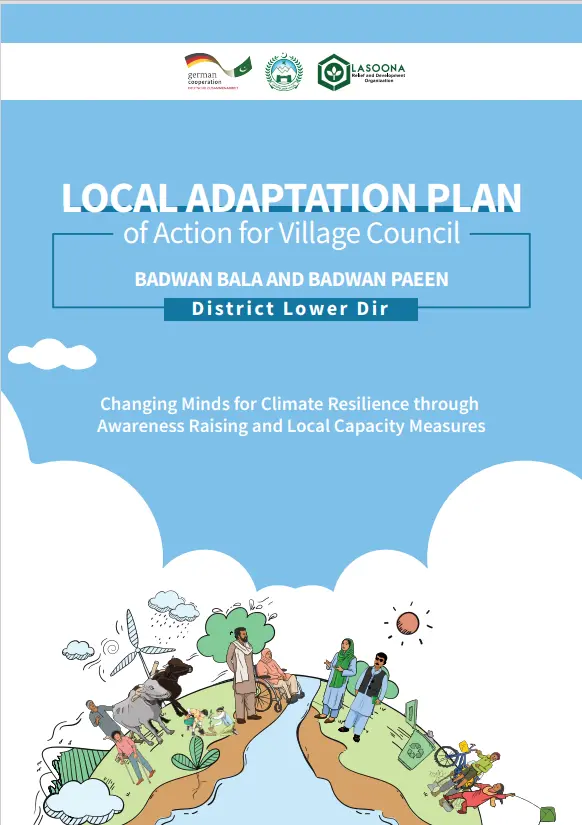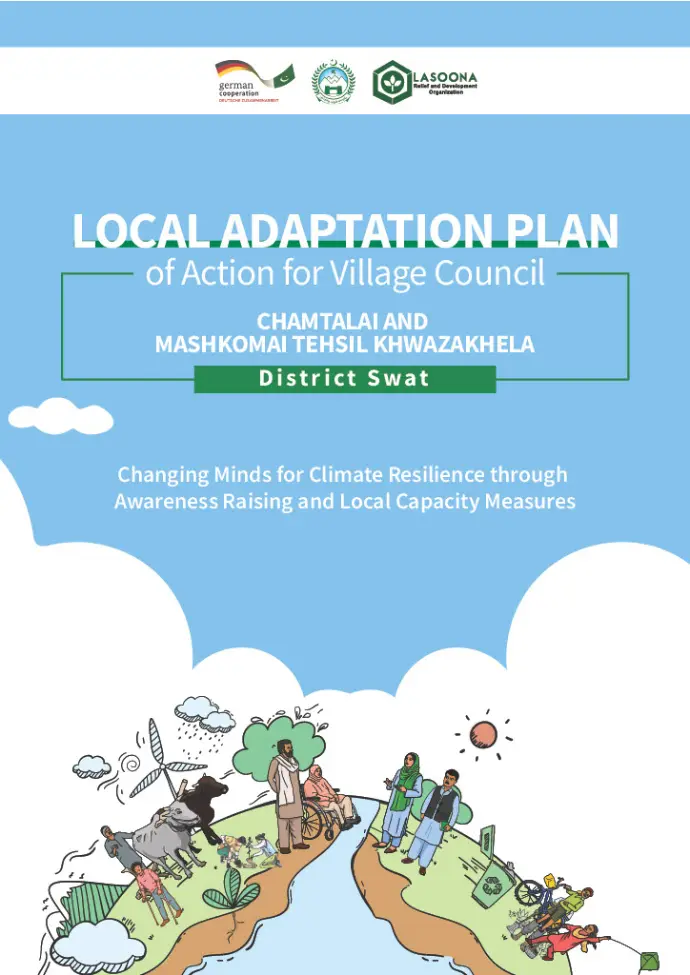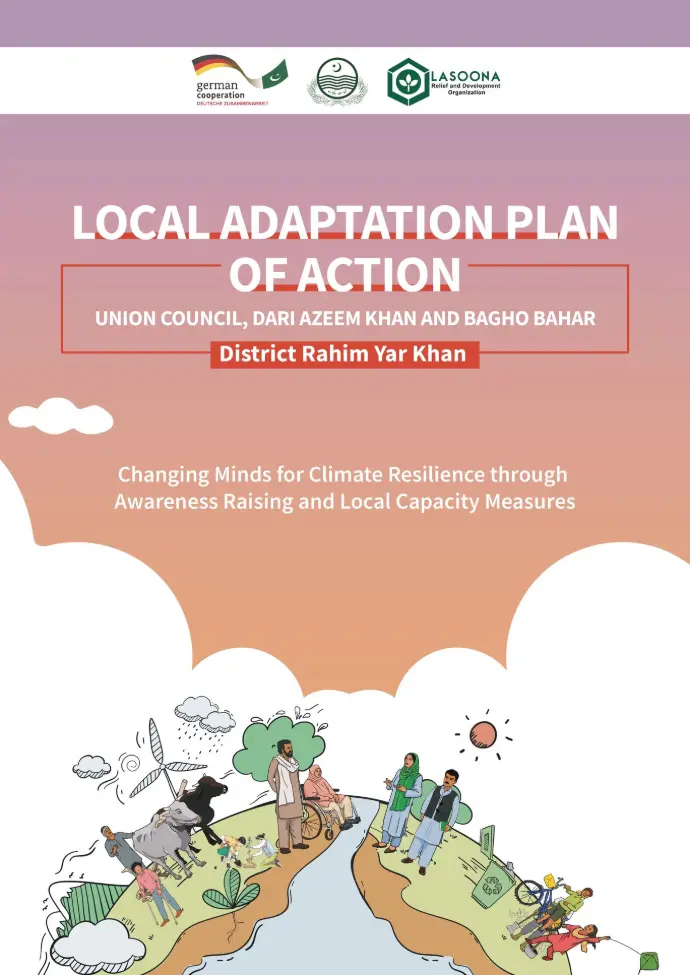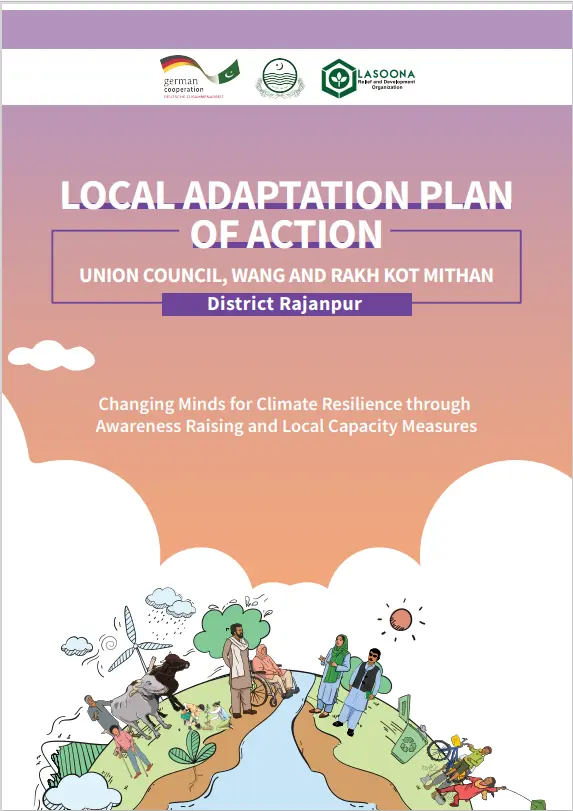Local Adaptation Plans of Action (LAPAs)
(LAPAs) in Khyber Pakhtunkhwa and Punjab
Background
The Local Adaptation Plans (LAPA) were prepared by the Relief and Development Organization (LASOONA) with financial support provided by the German Federal Ministry for Economic Cooperation and Development (BMZ) and support by the Deutsche Gesellschaft für International Zusammenarbeit (GIZ) GmbH in 04 selected districts Swat and Dir Lower in KPK and Rahim Yar Khan and Rajanpur in Punjab. In line with National Adaptation Plan, the development of a Local Adaptation Plan is crucial for building climate resilience at the community level.
Objective
The Local Adaptation Plan (LAPA) is a strategic framework designed to help communities and local governments effectively respond to the challenges posed by climate change. It aims to identify and address the specific vulnerabilities of a region, focusing on sectors such as Climate Change/Disaster Risk Reduction, Agriculture, Water, Sanitation, and Hygiene. LAPAs emphasize the importance of integrating climate adaptation measures into local development planning, ensuring that communities can build resilience to climate impacts like floods, droughts, and extreme heat. By involving key stakeholders, including local authorities, NGOs, and vulnerable groups, LAPAs promote a participatory approach that empowers communities to adapt. They also establish a clear mechanism for resource mobilization, capacity building, and monitoring progress, ensuring that adaptation efforts are sustained and effective in the long term. Ultimately, LAPAs contribute to a more resilient, sustainable future by combining climate science with local knowledge to tailor solutions that meet the unique needs of each community.
Approach
These plans were developed through a rapid needs assessment process that involved consultations with relevant district officials across 16 villages. The methodology included evaluating the risks and vulnerabilities posed by climate change, identifying necessary adaptation measures, prioritizing actions, and integrating the plans with existing development processes. A key aspect of this approach was the involvement of a multi-disciplinary team of experts in Climate Change/Disaster Risk Reduction, Agriculture, Water, Sanitation, and Hygiene. This team conducted an extensive assessment of climate change impacts in the targeted villages, engaging directly with communities through focused group discussions and key informant interviews. Additionally, they collaborated with district officials from the District Disaster Management Unit (DDMU), the Department of Agriculture, the Forest Department, the Department of Health, and Public Health Engineering. These consultations, which encompassed both primary and secondary data, were integral to ensuring that the LAPAs were well-informed and tailored to the specific needs of the communities. Ultimately, the goal of LAPAs was to strengthen community and ecosystem resilience, decrease vulnerability, and promote sustainable development within the districts. The developed plans were presented to the concerned stakeholder and their finding were validated from them.
Adaptation
Pathways
To navigate uncertainties in climate projections, it's crucial to develop flexible, dynamic plans that can adapt to evolving conditions. This approach ensures that solutions are not locked into rigid frameworks, allowing for the anticipation of future risks and opportunities. By supporting informed decision-making, we can align short-term actions with long-term sustainability goals, ensuring that immediate efforts contribute to a resilient and sustainable future.
- Climate Risk Assessment: Climate change projections were derived using two Global Climate Models (GCM) and the CMIP6 scenarios, incorporating bias correction and statistical downscaling to assess district-level risks.
- Climate-Induced Hazards: The growing frequency and severity of climate hazards highlight the need for immediate adaptation, with risks to ecological balance, economic stability, and public welfare.
- Vulnerability Assessment: Women and Adolescent Girls, children, and older people often suffer from extreme heat, leading to short- and long-term health risks.
- Coping Mechanism & Capacity Assessment of departments as well as community in order to ensure ownership with the appropriate knowledge.
- Proposed Adaptation Measures: The strategies focus on strengthening resilience across agriculture, water resources, agriculture, sanitation, hygiene, and healthcare, alongside effective disaster risk reduction.
- Implementation Mechanism: Establishment of a Climate Adaptation Steering Committee” with representatives from key sectors (agriculture, irrigation, health, etc.). Provide policy guidance, mobilize resources, approve programs, and ensure coordination.
- Coordination and Partnerships: Regular meetings will enhance collaboration between government, NGOs, and the community and mobilize resources, engage stakeholders such as NGOs, UN agencies, and international donors to fund adaptation efforts coupled with public funding.
- Monitoring and Evaluation: Establish baseline data, track progress regularly, engage stakeholders for feedback, and implement adaptive management practices and streamline with accountability and transparency by making records accessible to the public.
Lessons Learned
- Community Engagement is Key: Actively involving local communities ensures that adaptation plans are grounded in practical, context-specific needs and foster local ownership.
- Interdepartmental Collaboration Enhances Outcomes: Collaboration with multiple sectors and departments, such as agriculture, health, and disaster management, ensures comprehensive and integrated planning.
- Data-Driven Approaches Improve Relevance: Combining primary and secondary data enhances the credibility and accuracy of vulnerability assessments and proposed interventions.
- Capacity Building is Essential: Providing training and awareness to both communities and officials helps ensure the sustainability of adaptation measures
- Flexibility Enables Adaptability: Allowing room for plan adjustments based on evolving climate conditions and new findings ensures long-term effectiveness.
- Validation Strengthens Credibility: Presenting plans to stakeholders for validation promotes trust, accountability, and alignment with local priorities.
Conclusion
The LAPAs in KP and Punjab demonstrate the potential of locally driven adaptation to foster resilience against climate change. By leveraging community engagement, evidence-based planning, and multi-stakeholder collaboration, these plans provide a robust framework for scaling adaptation efforts. Moving forward, continuous learning, adequate resource allocation, and strong policy support will be critical to sustaining and replicating these successes across Pakistan.
Adaptation Plan for Lower Dir
Dir was a small Princely State in Khyber Pakhtunkhwa Province. Bordering Chitral, this State was located in the valley of River Panjkora, which originates in the Hindu Kush Mountains and joins the Lower Dir River near Chakdara..... Read more
Adaptation Plan for Lower Swat
Swat Valley is located in the northern part of Khyber Pakhtunkhwa province, with coordinates of approximately 35 North Latitude and 72 to 30 East Longitude. The valley is surrounded by towering mountains, creating a picturesque ..... Read more
Adaptation Plan for Rahim Yar Khan
District Rahim Yar Khan faces a range of climate impacts, including rising temperatures, irregular rainfall patterns, and predictive data suggesting a future exacerbation of these challenges. These environmental shifts have profound ..... Read more
Adaptation Plan for Rajanpur
District Rajanpur in Punjab is currently grappling with a range of climate change impacts, and these effects are significantly impacting key sectors within the district. Here is an overview of these climate change impacts and their specific effects ..... Read more



